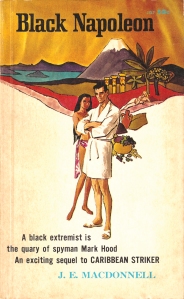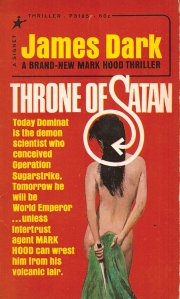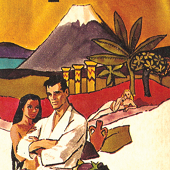 This week, Guest Star David Foster writes about how an Australian pulp thriller is altered when it was published in the United States as part of the Mysterious Order of the Skeleton Suit‘s Swapathon. Comics Editor Carol will be back in April.
This week, Guest Star David Foster writes about how an Australian pulp thriller is altered when it was published in the United States as part of the Mysterious Order of the Skeleton Suit‘s Swapathon. Comics Editor Carol will be back in April.
There are many elements that made up the counter culture movement of the Sixties and Seventies. One of the most important of these elements was the Civil Rights Movement, whose aim was equality no matter what race, colour, creed or religion. While that fight continues to this day, in early 1967 a story was released that showcased the changing social values the civil rights movement had brought about.
In Australia, that story was released as Black Napoleon, penned by veteran Australian author J.E. Macdonnell. Macdonnell already had a substantial following with his numerous navy action books, but the sixties spy boom saw him scribing a series of espionage titles featuring an agent for Intertrust, Mark Hood. Black Napoleon (Horwitz Publications) was the seventh title in the Hood series.
Black Napoleon is a pretty slight read. Not that the Mark Hood books were ever jam packed with densely intricate plots, but this story is wafer thin. However one of the aspects that makes this book interesting, particularly those who enjoy the James Bond film, You Only Live Twice, is it features a villain housed in a volcanic lair. The volcanic lair has become a hoary, old chestnut, parodied mercilessly in books and films ever since, but as Black Napoleon was first published in May, 1967 and You Only Live Twice was not released in Australia until December, 1967, it is most likely a coincidence. After all, the volcanic lair has been used frequently in spy and adventure fiction, most noticeably in The Island of Dr. Fu Manchu, written by Sax Rohmer in 1941 and the film Our Man Flint, released in early 1966.
And in Black Napoleon, Mark Hood’s colleague and fellow Intertrust agent, Tommy Tremayne, who has been captured, is about to be brought before the megalomaniac, Dominat.
As the plane banked away from the top of the mountain and beamed in again in a wide circle, the Englishman could look down into the dead crater beneath them. Running across its diameter was a wide steel platform. The plane was dropping. It passed right over the top of the mountain then turned again. The runway was rushing towards them, a ribbon of glittering grey metal. Borja had pulled out a large white handkerchief from his pocket and was feverishly mopping his brow. When he pulled the handkerchief away it was saturated. “We have a very good pilot,” he said in a low voice, as if it were he himself who needed convincing.
Now that they were practically level with the runway that ran across the diameter of the crater, it looked much longer than it had done from the air. The plane was small and maneuverable. Tremayne closed his eyes and waited for the impact of touchdown.
There was a squeal as the wheels gripped the rough steel. Then the aircraft was turning. They stopped and the silence, after the steady hum of the motors, was almost tangible. Tremayne opened his eyes.
Borja’s face had been drained of all its colour. His lips were trembling.
“The end of the ride?” Tremayne asked.
“We will wait here,” Borja croaked. He was not smiling now.
They waited. Then, beneath them, was a distant hum of machinery and, without being aware of any movement, Tremayne could see the inner walls of the crater closing in over them. Then he realized that they were being carried down, plane and all, on top of the platform into the bowels of the mountain. (Black Napoleon, 33).
 The book itself is a strange double-hander with fellow Intertrust agent Tommy Tremayne, who has been captured, working from the inside, while Hood works from the outside. And while a two-pronged spy story still works, providing all the high points you would expect in a pulp adventure like this, it also has the problem of rendering the primary hero, Hood, slightly impotent.
The book itself is a strange double-hander with fellow Intertrust agent Tommy Tremayne, who has been captured, working from the inside, while Hood works from the outside. And while a two-pronged spy story still works, providing all the high points you would expect in a pulp adventure like this, it also has the problem of rendering the primary hero, Hood, slightly impotent.
But it isn’t just the use of a hollowed out volcano that make the story interesting. The villain of the piece was a black militant leader named Dominat. From his secret scientific laboratory he has invented a range of highly sophisticated weapons with which he intends to take over the world. Black villains were nothing new to spy fiction. The obvious example is Ian Fleming’s Live and Let Die, where James Bond comes up against a giant African-American crime lord named Mr. Big. As an adjunct here, it is worth noting that the film of Live and Let Die, while still maintaining Black villains, owes more to the success of films such as Shaft, than Fleming’s original novel.
The Black menace is first described as a secret gathering, as the African-American populace leave the United States en masse:
By July the figure was reduced even more. Flurried statisticians deduced that the negro inhabitants of these cities had been whittled away to about half. Nervousness gave way to panic. There seemed no logical reason for the move. Questions were met only with a stony silence or an evasive flickering of the eyes.
There were hints, of course, rumours that drifted like elusive wisps of smoke. Some said that the move heralded in some way the second coming of Christ, that they had sensed a period of darkness that was soon to engulf the world. The panic increased.
To trained observers, however, it soon became apparent that the motivation behind the migration was not a supernatural one. There were other movements, more secretive ones, which attracted attention in certain quarters.
The leaders of the ultra-nationalistic negro action groups were leaving the country. They left furtively, traveling in the most roundabout way, posing as tourists, businessmen, and, in the end, after all precautions had been taken, they met.
The final conference had been called.
Deep in the bowels of an extinct volcano at the northern tip of the island of Domenica, a tall coffee-coloured man scraped his chair along the floor as he rose to speak. He spoke.
“Gentlemen, our hands have been forced” (1-2).
The coffee-coloured man in question is, of course, Dominat. Here the story skips forward to May, 1967, and across the ocean to the United States. On the second day of that month, the Black Panthers (or more correctly, the “Black Panther Party for Self Defense”) made world headlines when they stormed the California State Assembly in Sacramento bearing arms. FBI Director J. Edgar Hoover called the Panthers “the greatest threat to the internal security of the country.”
 But what did this have to do with an Australian spy novel?
But what did this have to do with an Australian spy novel?
Before proceeding, I must say the following is only conjecture, as I cannot truly know what the mood at Signet Publishing was in 1967. But the dates add up, and the evidence to support the conjecture is based on the way Black Napoleon was appeared on store shelves in the United States. But I am getting ahead of myself…
In the United States, Macdonnell’s Mark Hood thrillers were released by Signet Books under the pen name James Dark. At that time, Signet had an extensive espionage catalog releasing not only the James Bond series, but thrillers from Bill S. Ballinger, William Haggard, Richard Henry, and Michael Clayton.
On occasion, the Hood thrillers had their titles changed for the American market. Black Napoleon became Throne of Satan. However when Throne of Satan was released, all description of Dominat’s race is removed. Furthermore, the whole opening chapter, which established the gathering storm had been excised. Put simply, the villains in the book were no longer Black.
As Dominat is introduced in the Australian edition, Black Napoleon: “’Borja’s been telling me about you,’ he said, his face composed but with a studied negligence, almost insolence, in his voice. ‘The Black Napoleon, no less’” (36).
In the U.S. edition, Throne of Satan: “’Borja’s been telling me about you,’ he said, his face composed but with a studied negligence, almost insolence, in his voice. ‘The scientific genius with a yen for the macabre’” (47).
From the back of Black Napoleon:
BLACK NAPOLEON. An exciting sequel that goes right on where Caribbean Striker concluded (Tremayne obliterated).
Inside an extinct volcano a negro extremist weaves a strange web that Intertrust knows nothing of. But – ignoring the knife of his beautiful companion in bed – super spy Mark Hood discovers a trail. And sudden devastation is left in the wake of a humanoid typhoon.
From the back: Throne of Satan:
DOMINAT is his name: He’s the prince of an infernal scientific kingdom situated miles deep inside the walls of a volcanic crater on the West Indian island of Dominica. He possesses an ultimate weapon geared to destroy the world’s armies and navies. After which event, Dominat will crown himself emperor.
MARK HOOD has to get into Dominat’s electronic torture palace – without Tommy Tremayne. His fellow Intertrust agent is already there and about as safe as an icicle in hell. Hood figures out a way to accomplish his mission: woo a singularly treacherous beauty, and play her usual night-games! And if that romantic ploy fails, there’s always … MURIMOTO.
Was J.E. Macdonnell’s old fashioned (and out-dated) prose considered too incendiary to published at that time? It is clear that Signet believed the content was no longer appropriate for an espionage thriller–a brave move in genre that had a long history of presenting broad, crude racial stereotypes.
~~~
David James Foster writes under the pen name, James Hopwood. He is the author of the retro-spy thrillers, The Librio Defection and The Danakil Deception (coming soon from Pro Se). His short fiction has been published by Sempre Vigil Press, Crime Factory, and Pro Se Publications.
Writing as Jack Tunney, he also scribed King of the Outback and Rumble in the Jungle, books in the popular Fight Card series. He also contibuted to Iron Head and Other Stories–an anthology released by Fight Card to aid literary charities and authors in need.
David lives in Melbourne, Australia. You can find out more at his website http://permissiontokill.com/
Categories: Guest Star





